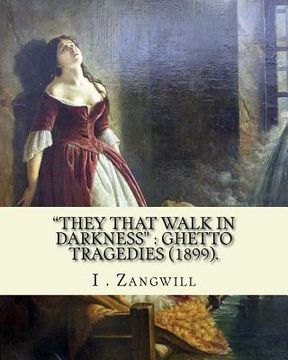"They that walk in darkness": ghetto tragedies (1899).: By: I . Zangwill, Illustrated By: Louis Loeb (November 7, 1866 - July 12, 1909) was a Jewish (en Inglés)
Reseña del libro ""They that walk in darkness": ghetto tragedies (1899).: By: I . Zangwill, Illustrated By: Louis Loeb (November 7, 1866 - July 12, 1909) was a Jewish (en Inglés)"
Louis Loeb (November 7, 186 - July 12, 1909) was a Jewish illustrator in the United States. In his time, he was one of the best known in his field.He was also a draftsman, a painter, and a lithographer. Biography[edit] Born in Cuyahoga County, Ohio to Alexander Loeb, a dry goods merchant, Louis Loeb worked at a Cleveland lithography firm from age 14 onwards, [2] later taking evening classes in sketching at the Cleveland Art Club.[2][4] In 1885, he worked at a lithography firm in New York City, with his evenings spent at the Art Students League. In 1889 he went to Paris to study, under Lefebvre, Constant, and Gérôme, giving up lithography. After three years he returned to New York, where in 1893 he started work for The Century Magazine as an illustrator. For the next few years, up until 1900, he was to travel to and from Europe, both for study and in the course of his work for The Century. During the remainder of his life, he stayed in the U.S., dying in Canterbury, New Hampshire................ Israel Zangwill (21 January 1864 - 1 August 1926) was a British author at the forefront of cultural Zionism during the 19th century, and was a close associate of Theodor Herzl. He later rejected the search for a Jewish homeland and became the prime thinker behind the territorial movement. Early life and education: Zangwill was born in London on 21 January 1864, in a family of Jewish immigrants from the Russian Empire. His father, Moses Zangwill, was from what is now Latvia, and his mother, Ellen Hannah Marks Zangwill, was from what is now Poland. He dedicated his life to championing the cause of people he considered oppressed, becoming involved with topics such as Jewish emancipation, Jewish assimilation, territorialism, Zionism, and women's suffrage. His brother was novelist Louis Zangwill. Zangwill received his early schooling in Plymouth and Bristol. When he was nine years old, Zangwill was enrolled in the Jews' Free School in Spitalfields in east London, a school for Jewish immigrant children. The school offered a strict course of both secular and religious studies while supplying clothing, food, and health care for the scholars; presently one of its four houses is named Zangwill in his honour. At this school he excelled and even taught part-time, eventually becoming a full-fledged teacher. While teaching, he studied for his degree from the University of London, earning a BA with triple honours in 1884. Writings: He had already written a tale entitled The Premier and the Painter in collaboration with Louis Cowen, when he resigned his position as a teacher owing to differences with the school managers and ventured into journalism. He initiated and edited Ariel, The London Puck, and did miscellaneous work for the London press. Zangwill's work earned him the nickname "the Dickens of the Ghetto". He wrote a very influential novel Children of the Ghetto: A Study of a Peculiar People (1892). The use of the metaphorical phrase "melting pot" to describe American absorption of immigrants was popularised by Zangwill's play The Melting Pot, [4] a success in the United States in 1909-10. When The Melting Pot opened in Washington D.C. on 5 October 1909, former President Theodore Roosevelt leaned over the edge of his box and shouted, "That's a great play, Mr. Zangwill, that's a great play." In 1912 Zangwill received a letter from Roosevelt in which Roosevelt wrote of the Melting Pot "That particular play I shall always count among the very strong and real influences upon my thought and my life."...........................

